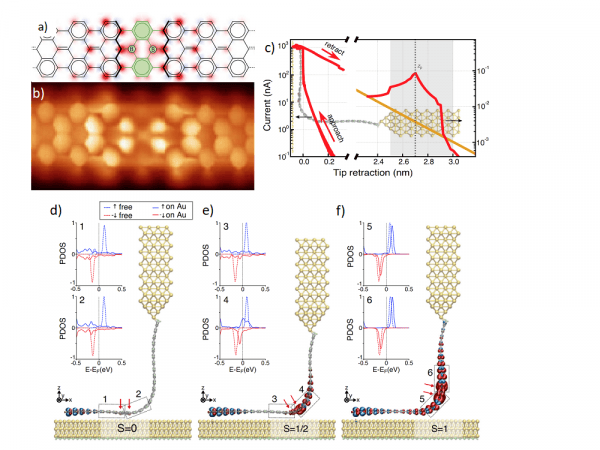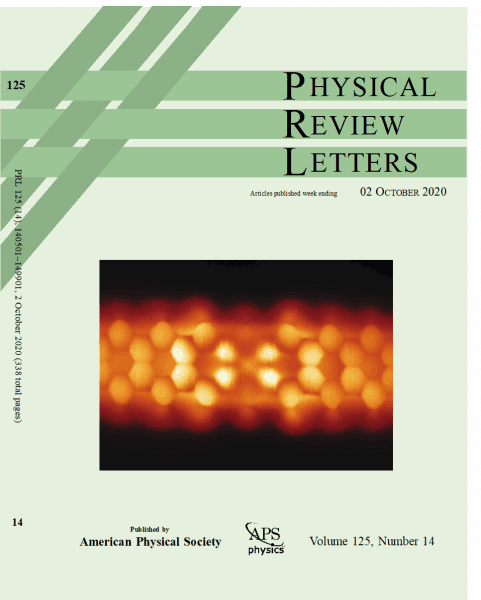Magnetism of topological boundary states induced by boron substitution in graphene nanoribbons
 Graphene nanoribbons (GNRs), low-dimensional platforms for carbon-based electronics, show the promising perspective to also incorporate spin polarization in their conjugated electron system. However, these magnetic moments are usually localized around zigzag edges, difficult to fabricate and very reactive. This combined theoretical and experimental study demonstrates that magnetism can also be induced away from physical edges through atomically precise engineering of topological defects in its interior. A pair of substitutional boron atoms inserted in the carbon backbone breaks the conjugation of their topological bands and builds two spin-polarized boundary states around them.
Graphene nanoribbons (GNRs), low-dimensional platforms for carbon-based electronics, show the promising perspective to also incorporate spin polarization in their conjugated electron system. However, these magnetic moments are usually localized around zigzag edges, difficult to fabricate and very reactive. This combined theoretical and experimental study demonstrates that magnetism can also be induced away from physical edges through atomically precise engineering of topological defects in its interior. A pair of substitutional boron atoms inserted in the carbon backbone breaks the conjugation of their topological bands and builds two spin-polarized boundary states around them.
GNRs can be classified according to the topology of their electronic band structures. This allows predicting the appearance of zero-energy states bound at the boundaries between GNRs of different topological classes or at the edges of topologically non-trivial ribbons. These localized states give rise to spin polarization once electron-electron repulsion is taken into account. Beyond an academic problem, this offers the promise of using topology to induce magnetism in carbon-based platforms. Unfortunately, the magnetism of topologically protected boundary states in carbon systems had yet to be demonstrated, while topological engineering of boundary states seems restricted to exotic cases, always involving the highly reactive zigzag edges.
The authors of this work show that magnetic boundary states can be created in the interior of a GNR simply by embedding substitutional heteroatoms in the carbon backbone. A pair of boron atoms substituting carbon turns out to act as a physical termination for the topological valence band of the ribbon (7-AGNR) and, hence, creates end states that are singly occupied and spin polarized. First indications of the presence of magnetism were given by the appearance of characteristic Kondo peaks in electrical transport experiments performed at CIC nanoGUNE. Transport was measured through boron-substituted GNRs suspended between the tip and the sample of a Scanning Tunneling Microscope (STM). These observations were rationalized in terms of the theory and first-principles simulations performed at CFM and DIPC, which predicted for each isolated boron pair a S=1 spin state as well as a strong dependence on the spacing between pairs. The interaction between two of such topological defects was further explored, outlining a route to engineer topological spin chains, with the promising tunability of their magnetism by modifying their spacing.
This work presents a remarkable combination of high precision electrical transport experiments of an atomically perfect system in a free-standing configuration between source/drain electrodes with atomistic simulations of the experimental configuration (involving a large number of atoms). These complex simulations were further used to develop and parametrize intuitive models governing the onset of magnetism in this system.

Figure: a) Structure of the 2B-7AGNR defect shown over a color map representing the computed spin polarization density map (green represents the boron moiety). b) Constant height STM scan (V=2 mV) using a CO-functionalized tip of a 2B-7AGNR defect. c) Tunneling current I at V=25 mV as a function of z for a borylated (red) and a pristine (orange) GNR, for comparison. Observe the large current increase around the point (zp) at which the B-pair is detached from the substrate. (d)–(f) Relaxed structures of three different configurations of a 2B-7AGNR bridging a gold tip and a Au(111) surface (red arrows indicate the B atoms). Constant spin density isosurfaces are shown with spin up in blue and down in red. Insets compare spin PDOS over C atoms within the boxed regions around each boron atom for each bridge geometry (solid lines), with the corresponding one of a free 2B-7AGNR (dashed lines).




 Graphene nanoribbons (GNRs), low-dimensional platforms for carbon-based electronics, show the promising perspective to also incorporate spin polarization in their conjugated electron system. However, these magnetic moments are usually localized around zigzag edges, difficult to fabricate and very reactive. This combined theoretical and experimental study demonstrates that magnetism can also be induced away from physical edges through atomically precise engineering of topological defects in its interior. A pair of substitutional boron atoms inserted in the carbon backbone breaks the conjugation of their topological bands and builds two spin-polarized boundary states around them.
Graphene nanoribbons (GNRs), low-dimensional platforms for carbon-based electronics, show the promising perspective to also incorporate spin polarization in their conjugated electron system. However, these magnetic moments are usually localized around zigzag edges, difficult to fabricate and very reactive. This combined theoretical and experimental study demonstrates that magnetism can also be induced away from physical edges through atomically precise engineering of topological defects in its interior. A pair of substitutional boron atoms inserted in the carbon backbone breaks the conjugation of their topological bands and builds two spin-polarized boundary states around them.